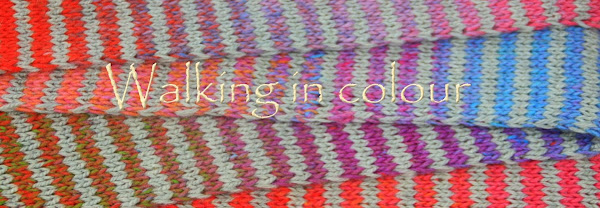In this blog post, rather than ramble on about what I have
been making, I thought that I would pass on a few pearls of wisdom concerning
a practical aspect of knitting……yarn substitution. Inexperienced knitters may
lack the confidence to use a yarn other than that recommended in a pattern, this
is a shame because being able to use different yarns opens up all sorts of
possibilities. How many times have you admired a pattern but wanted to knit it
in cotton instead of wool, or in a colour that just is not available in the
range suggested? Perhaps you are keen to use a locally produced yarn, or you just couldn't resist that hand-dyed alpaca and silk yarn you saw at a fibre show. In my case, I have experienced ALL of those reasons! I also can't resist mixing yarns, perhaps a strand of lace weight with a 4 ply, or a strand of mohair with a sock yarn. The possibilities of yarn substitution are only limited by your imagination.
Looking back, I don’t
think that I have ever used the yarn suggested in a pattern and have learned,
by trial and error, how to go about substituting yarn and still end up with a
usable garment. At first I thought, like many new knitters, that if the
pattern was written for a specific weight of yarn, such as DK, then all I had
to do was choose another DK yarn and all would be hunky dory. Sometimes it
worked and sometimes it didn’t. I soon realised that I needed to have a more organised approach and now I have a method that I am happy with. So, here we go, a little foray into yarn
substitution.
The key to successful yarn substitution is swatching. I have
met knitters who would rather chew off their right arm than knit a swatch and I
must admit I was often so impatient to start on a garment that I severely
resented the time spent on swatching. I am now a total convert, I actually enjoy the process. It is worth it for several reasons, all of which will save
you time and energy (and sanity) in the
long run.
You can determine whether your garment will end up the size you want
The yarn
may look very similar in weight but your lovingly worked jumper may end up
inches bigger or smaller.
You can determine the best needle size to achieve the correct fabric
You don’t have to use the sizes stated in the pattern but
you do need to give this some thought.
You can examine the swatch fabric to make sure that it has the properties that you want
Cotton behaves
very differently to wool, it tends to stretch with wear so you may want to consider whether this will
affect the result that you are looking for. If the pattern involves Fair-Isle
or delicate textural features you can make sure that your chosen yarn will do
it justice. A very fuzzy yarn may come in
gorgeous colours but sharp colour
changes will be lost and the overall effect will be disappointing. If the
garment is to be worn next to your skin it is important that the fabric feels
comfortable. Does the swatch have the drape that you require? Is it too stiff,
too open, too thick, too thin? Or, is it just right?
Just in case there are readers who have never swatched at
all, in my next post I will guide you through the process, hopefully quite
painlessly.
Until then, cheerio.
Until then, cheerio.

No comments:
Post a Comment